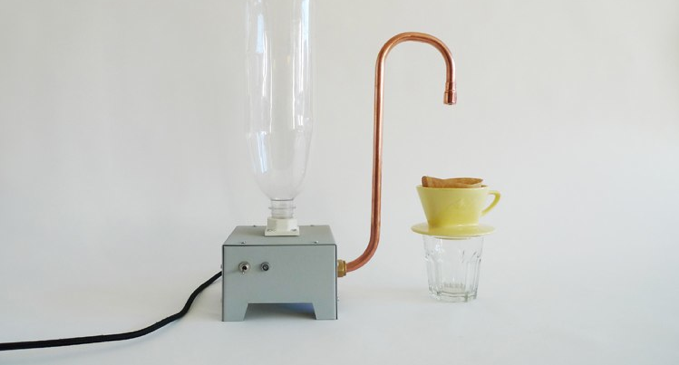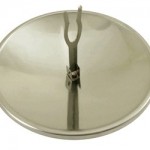“Instead of a big solar oven that adapts to our conventional idea of cooking, The GoSun requires a bit of adaptation of our diet. But that really is a feature, not a bug; it can be a healthier diet with less food waste.” Read more: GoSun stove reinvents solar cooking.
Open Source Water Boiler
“Coffee makers and water boilers are relatively simple machines, yet their workings are typically inaccessible to the user. Repair or even recycling becomes impossible: once the product ceases to function, it is rendered disposable. The OS Boiler explores an alternative approach to the design and production of these ubiquitous appliances. Based on the OS design principles, the WaterBoiler’s (completely disassembleable) design and transparent construction invites users to adapt, repair, and combine with existing OpenStructures components.”
“The limited complexity of the Boiler allows new partnerships to emerge that can adapt to the scale of production: a single unit designed as a DIY kit to one-thousand units produced in a collaboration of international suppliers and local manufacturers. Consistent application of simple and straightforward principles in design and production leads to an object that can evolve and adapt over time.”
Open Source Water Boiler (and the version with ceramic filter) at the OpenStructures Project.
For an in-depth article about OpenStructures and related projects, read “How to make everything ourselves: open modular hardware“.
The Poor Man’s Refrigerator
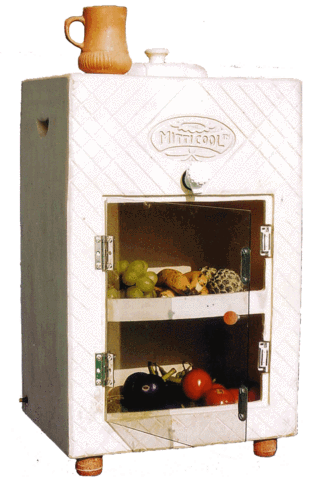 “A fridge for the common man that does not require electricity and keeps food fresh too. With this basic parameter in mind Mansukhbhai came up with Mitticool, a fridge made of clay.
“A fridge for the common man that does not require electricity and keeps food fresh too. With this basic parameter in mind Mansukhbhai came up with Mitticool, a fridge made of clay.
It works on the principle of evaporation. Water from the upper chambers drips down the side, and gets evaporated taking away heat from the inside , leaving the chambers cool.
The top upper chamber is used to store water. A small lid made from clay is provided on top. A small faucet tap is also provided at the front lower end of chamber to tap out the water for drinking use.
In the lower chamber, two shelves are provided to store the food material. The first shelf can be used for storing vegetables, fruits etc. and the second shelf can be used for storing milk etc. Cool and affordable, this clay refrigerator is a very good option to keep food, vegetables and even milk naturally fresh for days.”
MittiCool Refrigerator. Thanks for the tip, Joseph. See also:
How to Keep Beverages Cool Outside the Refrigerator
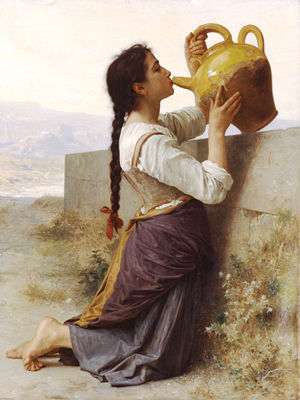 In the industrialized world, we know only of one way to cool beverages: place containers in refrigerators. This practice, which occurs on a massive scale, is utterly dependent on fossil fuels.
In the industrialized world, we know only of one way to cool beverages: place containers in refrigerators. This practice, which occurs on a massive scale, is utterly dependent on fossil fuels.
However, people obtained the same result much more sustainably before the advent of the Industrial Revolution. In hot, dry climates, we used porous earthenware jugs that were not only re-usable, but also kept water cool by taking advantage of natural energy sources.
The best known example is the Spanish ‘botijo’, an unglazed ceramic container that cools beverages by evaporation. Similar drinking containers can be found in other Mediterranean countries, as well as in Mexico (where it is known as a ‘búcaro’) and on the Indian subcontinent (where it is called a ‘ghara’, ‘matka’ or ‘suhari’).
The ceramic water cooler probably originated in the Indus Valley Civilization, which would make it 5000 years old.
Ceramic Food Steamer With Central Chimney
Steaming food (vegetables as well as fish, meat and rice) is an interesting cooking method, mainly for two reasons: contrary to frying there is no need to use fat, and compared to both frying and boiling less nutrients are lost.
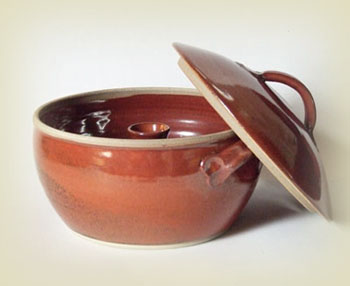 Almost all food steamers or steam cookers on the market work by virtue of many little holes, through which the steam rises from the boiling water below. The disadvantage of this method is that you lose the bouillon of the food, as well as the spices you might add.
Almost all food steamers or steam cookers on the market work by virtue of many little holes, through which the steam rises from the boiling water below. The disadvantage of this method is that you lose the bouillon of the food, as well as the spices you might add.
When I visited my cousin last week in the French Dordogne, I stumbled upon a ceramic steamer in her kitchen. It was hand made by Laurent Merchant, an artisan living and working in the region. Ceramic food steamers are everything but new — they were already used in Neolithic China 6 to 7000 years ago* — but this one was different. Just like any other steam cooker, it is placed above a pot with boiling water. However, the steam enters through a central chimney rather than through dozens of little holes. The obvious advantage is that you don’t lose the juice, which greatly increases the potential uses of steaming.
Some commercially available steamers feature a condensation catchment, but in that case you can only use the bouillon separately, or add it to the food later. Furthermore, the ceramic steamer offers several additional advantages. Its design allows you to easily warm up earlier made dishes or leftovers following the same cooking method, because the device also serves as a perfect storage container and the steam prevents the food from drying out or sticking together. The steam cooker is also particularly suitable for defrosting food, and it is much easier to clean than conventional devices. Last but not least, it is made from sustainable materials and looks great, which cannot be said of most plastic food steamers.
Laurent Merchant did not invent the device, which he dubbed “Le steamer”. Ceramic steamers with a central chimney originated in China, where they might have been in use for many centuries in the region around Shanghai. They resurfaced in California in the 1970s, where the artisan saw them for the first time. I could not find any information on their history, but in 2007 Merchant stumbled upon an authentic Chinese specimen which he could photograph (picture on the right — more pictures here).
“Le steamer” is available in different sizes (from 1 to 4.5 litres) and can be ordered online. Laurent Merchant’s website is in French, but he will answer your questions in perfect English.
* Joseph Needham, Science and Civilisation in China, Volume 5, part 5: fermentations and food science, page 76-91
